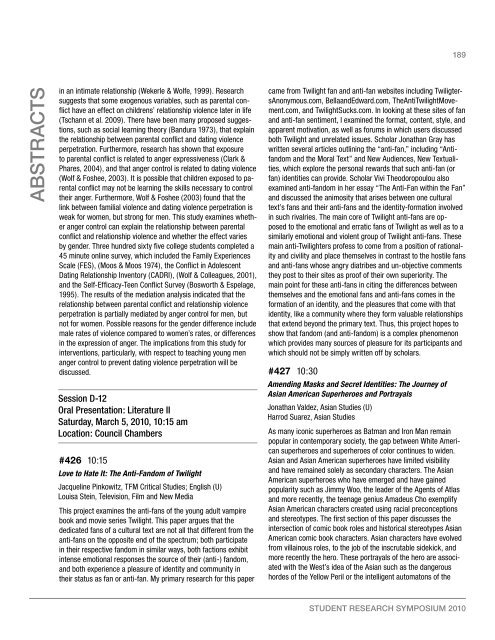STUDENT RESEaRch SympoSiUm 2010 - Graduate and Research ...
STUDENT RESEaRch SympoSiUm 2010 - Graduate and Research ...
STUDENT RESEaRch SympoSiUm 2010 - Graduate and Research ...
Create successful ePaper yourself
Turn your PDF publications into a flip-book with our unique Google optimized e-Paper software.
AbstrActs<br />
in an intimate relationship (Wekerle & Wolfe, 1999). <strong>Research</strong><br />
suggests that some exogenous variables, such as parental conflict<br />
have an effect on childrens’ relationship violence later in life<br />
(Tschann et al. 2009). There have been many proposed suggestions,<br />
such as social learning theory (B<strong>and</strong>ura 1973), that explain<br />
the relationship between parental conflict <strong>and</strong> dating violence<br />
perpetration. Furthermore, research has shown that exposure<br />
to parental conflict is related to anger expressiveness (Clark &<br />
Phares, 2004), <strong>and</strong> that anger control is related to dating violence<br />
(Wolf & Foshee, 2003). It is possible that children exposed to parental<br />
conflict may not be learning the skills necessary to control<br />
their anger. Furthermore, Wolf & Foshee (2003) found that the<br />
link between familial violence <strong>and</strong> dating violence perpetration is<br />
weak for women, but strong for men. This study examines whether<br />
anger control can explain the relationship between parental<br />
conflict <strong>and</strong> relationship violence <strong>and</strong> whether the effect varies<br />
by gender. Three hundred sixty five college students completed a<br />
45 minute online survey, which included the Family Experiences<br />
Scale (FES), (Moos & Moos 1974), the Conflict in Adolescent<br />
Dating Relationship Inventory (CADRI), (Wolf & Colleagues, 2001),<br />
<strong>and</strong> the Self-Efficacy-Teen Conflict Survey (Bosworth & Espelage,<br />
1995). The results of the mediation analysis indicated that the<br />
relationship between parental conflict <strong>and</strong> relationship violence<br />
perpetration is partially mediated by anger control for men, but<br />
not for women. Possible reasons for the gender difference include<br />
male rates of violence compared to women’s rates, or differences<br />
in the expression of anger. The implications from this study for<br />
interventions, particularly, with respect to teaching young men<br />
anger control to prevent dating violence perpetration will be<br />
discussed.<br />
Session D-12<br />
Oral Presentation: Literature II<br />
Saturday, March 5, <strong>2010</strong>, 10:15 am<br />
Location: Council Chambers<br />
#426 10:15<br />
Love to Hate It: The Anti-F<strong>and</strong>om of Twilight<br />
Jacqueline Pinkowitz, TFM Critical Studies; English (U)<br />
Louisa Stein, Television, Film <strong>and</strong> New Media<br />
This project examines the anti-fans of the young adult vampire<br />
book <strong>and</strong> movie series Twilight. This paper argues that the<br />
dedicated fans of a cultural text are not all that different from the<br />
anti-fans on the opposite end of the spectrum; both participate<br />
in their respective f<strong>and</strong>om in similar ways, both factions exhibit<br />
intense emotional responses the source of their (anti-) f<strong>and</strong>om,<br />
<strong>and</strong> both experience a pleasure of identity <strong>and</strong> community in<br />
their status as fan or anti-fan. My primary research for this paper<br />
189<br />
came from Twilight fan <strong>and</strong> anti-fan websites including TwiligtersAnonymous.com,<br />
Bella<strong>and</strong>Edward.com, TheAntiTwilightMovement.com,<br />
<strong>and</strong> TwilightSucks.com. In looking at these sites of fan<br />
<strong>and</strong> anti-fan sentiment, I examined the format, content, style, <strong>and</strong><br />
apparent motivation, as well as forums in which users discussed<br />
both Twilight <strong>and</strong> unrelated issues. Scholar Jonathan Gray has<br />
written several articles outlining the “anti-fan,” including “Antif<strong>and</strong>om<br />
<strong>and</strong> the Moral Text” <strong>and</strong> New Audiences, New Textualities,<br />
which explore the personal rewards that such anti-fan (or<br />
fan) identities can provide. Scholar Vivi Theodoropoulou also<br />
examined anti-f<strong>and</strong>om in her essay “The Anti-Fan within the Fan”<br />
<strong>and</strong> discussed the animosity that arises between one cultural<br />
text’s fans <strong>and</strong> their anti-fans <strong>and</strong> the identity-formation involved<br />
in such rivalries. The main core of Twilight anti-fans are opposed<br />
to the emotional <strong>and</strong> erratic fans of Twilight as well as to a<br />
similarly emotional <strong>and</strong> violent group of Twilight anti-fans. These<br />
main anti-Twilighters profess to come from a position of rationality<br />
<strong>and</strong> civility <strong>and</strong> place themselves in contrast to the hostile fans<br />
<strong>and</strong> anti-fans whose angry diatribes <strong>and</strong> un-objective comments<br />
they post to their sites as proof of their own superiority. The<br />
main point for these anti-fans in citing the differences between<br />
themselves <strong>and</strong> the emotional fans <strong>and</strong> anti-fans comes in the<br />
formation of an identity, <strong>and</strong> the pleasures that come with that<br />
identity, like a community where they form valuable relationships<br />
that extend beyond the primary text. Thus, this project hopes to<br />
show that f<strong>and</strong>om (<strong>and</strong> anti-f<strong>and</strong>om) is a complex phenomenon<br />
which provides many sources of pleasure for its participants <strong>and</strong><br />
which should not be simply written off by scholars.<br />
#427 10:30<br />
Amending Masks <strong>and</strong> Secret Identities: The Journey of<br />
Asian American Superheroes <strong>and</strong> Portrayals<br />
Jonathan Valdez, Asian Studies (U)<br />
Harrod Suarez, Asian Studies<br />
As many iconic superheroes as Batman <strong>and</strong> Iron Man remain<br />
popular in contemporary society, the gap between White American<br />
superheroes <strong>and</strong> superheroes of color continues to widen.<br />
Asian <strong>and</strong> Asian American superheroes have limited visibility<br />
<strong>and</strong> have remained solely as secondary characters. The Asian<br />
American superheroes who have emerged <strong>and</strong> have gained<br />
popularity such as Jimmy Woo, the leader of the Agents of Atlas<br />
<strong>and</strong> more recently, the teenage genius Amadeus Cho exemplify<br />
Asian American characters created using racial preconceptions<br />
<strong>and</strong> stereotypes. The first section of this paper discusses the<br />
intersection of comic book roles <strong>and</strong> historical stereotypes Asian<br />
American comic book characters. Asian characters have evolved<br />
from villainous roles, to the job of the inscrutable sidekick, <strong>and</strong><br />
more recently the hero. These portrayals of the hero are associated<br />
with the West’s idea of the Asian such as the dangerous<br />
hordes of the Yellow Peril or the intelligent automatons of the<br />
<strong>STUDENT</strong> RESEARCH SYMPOSIUM <strong>2010</strong>


